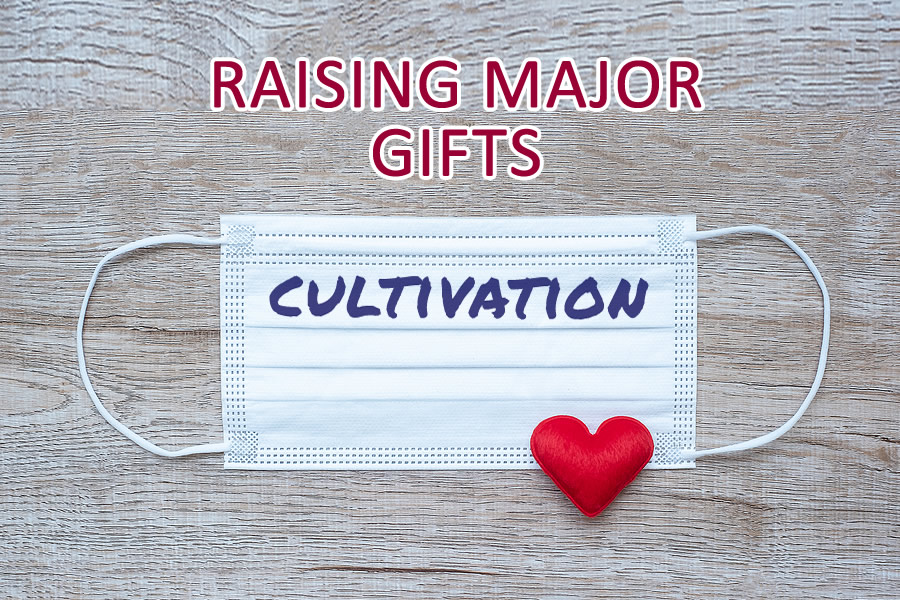
This is part two of my “back to basics” series on how to raise major gifts during Covid and beyond. Part one looked at donor identification (step 1 in the fundraising cycle).
Remember, there are four steps in the fundraising cycle:
- Identification – Who you will raise money from
- Cultivation – Building relationships with potential donors
- Solicitation – Asking for a gift
- Stewardship – Thanking and follow up
In this post, we’re taking a closer look at cultivation — in other words, relationship building.
Cultivation is All About Building Relationships
What does it mean to build relationships between individuals and organizations?
Affinity for your organization
When we talk about relationship building or cultivation, we’re talking about strengthening a donor’s affinity for an organization. It’s not the same as a relationship between two individuals — or, at least, it shouldn’t be.
If an Executive Director builds relationships with donors, but the relationship doesn’t extend far enough past the ED, then when that ED leaves the organization, the connection with the donor falls apart.
Ideally, donors should care about the institution and mission MORE than any single individual at a given organization. Hopefully, donors continue to support organizations they care about through staff and board turnover.
Cultivation is like dating
The best analogy for cultivation is dating. Generally, you don’t go on dates as a group (double dates aside). On a first date, it’s important to get to know the person you’re dating by asking questions about them… about what they do, their family, what interests them, etc. The same is true when building relationships with donors.
Most importantly, you probably don’t want to ask someone to marry you on a first date. Likewise, you don’t want to ask for a major or planned gift the first time you meet someone… and definitely not in a group setting.
Cultivation in a Post-COVID World
The best way to cultivate a donor is by getting to know them and asking questions. COVID hasn’t changed this.
The one thing that did change during the pandemic is most people’s comfort level with Zoom and other video chat technology. Take advantage of this by having your first meeting over Zoom, particularly if you can’t schedule something in person (more on this below).
COVID is likely to become endemic, meaning it will wax and wain with the seasons (much like the common flu). Therefore, there may still be times in a post-COVID world when social distancing is preferred.
New donors during COVID?
Did you bring in new donors during COVID? It’s as important as ever to cultivate them so they continue to give for years to come.
Develop a plan to find out why they gave during the pandemic and learn what might engage them or to motivate them to continue giving. If you can call them to thank them for their gifts, great! If you get them on the phone ask questions about why they gave.
In addition, send a short survey to all new donors:
- Ask on a scale of 1-5 how important your cause is to them.
- Ask them if they would like to volunteer.
- Provide a notes box for additional comments.
Then, follow up with those who respond.
Those who are engaged and involved with your organization, mission, and cause are most likely to become major donors. They don’t need to be millionaires to make generous gifts. Focus on getting donors involved and engaged and the money will follow.
Engaging Donors on Their Terms
One important component of cultivation is donor engagement. In other words, how can you involve donors in your organization?
In the past, tours and volunteerism were critical aspects of donor engagement. During COVID, many tours were canceled and some volunteer opportunities were suspended. As the virus continues to recede from our day-to-day lives, we need to recognize that even in a post-COVID world, some people will have changed their comfort level with such activities.
So, use technology to bridge the gap. Bring donors on interactive live tours where you provide opportunities to meet staff and clients through Zoom, and for donors to ask questions virtually. Some people prefer this over meeting in person.
Ideally, you’ll want to get to know your donors and find out what their comfort level is with meeting virtually versus in-person.
It’s time to be creative and build relationships with your donors regardless of the status of the pandemic. What are you doing to cultivate donors right now?

Hi!
Let me introduce myself as I’m a board member for a nonprofit national organization that serves Deaf and Hard of Hearing people all over the nation. I’m quite disappointed to find your videos with no closed-captioned or subtitle for me to learn how I can empower myself and my colleagues to do well with the fundraising, etc. I hope we can come to a solution in this matter.
Hope to hear back from you soon.
Smiles…
Hi Lisa – Thank you for your note. It is an excellent point and I will look into adding closed captions to all future videos. That being said, nearly all my videos are accompanied by text below them (in the post) so they can be read. And, I haven’t done videos in nearly 2 years, so all new and recent content is text only. But it’s also a great reminder to get back to making videos!
A good overview about fundraising